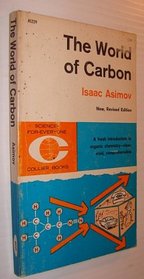THE BEST. I cannot recommend this book enough to anyone with even an inkling of interest into the world of organic chemistry. An introductory book that certainly holds charm enough for both the complete beginner as well as the more advanced student, the author takes what is dry and confusing information in many of the more recent textbooks and explains everything in wonderful, colorful terms that make sense in the real world. With his excellent writing style, you won't need to sit staring at a page to memorize a formula to understand the concepts he outlines- he brings the ideas to life so thoroughly, you'll remember just as easily as if you'd been reading a fascinating story. In fact, the entire book has the feel of being present during a 1-on-1 personal conversation or of listening to a clever lecture. The only chemistry book I've had the deep pleasure and delight to consider a "page turner". Asimov also authored a "companion book" to World of Carbon called World of Nitrogen, for any who read this and can't get enough, by the way.
Quoted from the back of the book:
Chemists divide all substances into two classes. In one class are such things as olive oil, sugar, starch, glue, gelatin, silk, rubber, paper, and penicillin. These are examples of organic substances. In the other class are such things as air, water, sand, clay, salt, gold, silver, iron, brass, glass, and concrete. These are examples of inorganic substances. The distinction between the two emerged when it became evident that organic substances are made up of molecules that almost always contained at least one carbon atom; it them became convenient to call any substance with carbon atoms in its molecule organic and any substance withut carbon atoms inorganic. In this way the world of organic chemistry came t be identified with the world of carbon.
In The World of Carbon, Isaac Asimov, introducing the study or organic chemistry, offers a clear, vivid, and comprehensible analysis of many of the most common organic compounds in our world. And he demonstrates how increased knowledge of the structure of these carbon compounds-from anesthetics and antifreeze to paint and perfume-has led to a better life for all of us.
Those common organic compounds not discussed in this volume are covered by Dr. Asimov in a companion volume that concentrates on carbon compounds containing at least one atom of nitrogen. Appropriately titled The World of Nitrogen, it is also available in Collier Books.
Isaac Asimov, Associate Professor of Biochemistry at Boston University School of Medicine, has gained international distinction as both a science writer and a writer of science fiction. His many works include The Bloodstream, The Clock We Live On, Marvels of Science, The Kingdom of the Sun, The World of Nitrogen, and Fifty Short Science Fiction Tales, all available in Collier Books.
Quoted from the back of the book:
Chemists divide all substances into two classes. In one class are such things as olive oil, sugar, starch, glue, gelatin, silk, rubber, paper, and penicillin. These are examples of organic substances. In the other class are such things as air, water, sand, clay, salt, gold, silver, iron, brass, glass, and concrete. These are examples of inorganic substances. The distinction between the two emerged when it became evident that organic substances are made up of molecules that almost always contained at least one carbon atom; it them became convenient to call any substance with carbon atoms in its molecule organic and any substance withut carbon atoms inorganic. In this way the world of organic chemistry came t be identified with the world of carbon.
In The World of Carbon, Isaac Asimov, introducing the study or organic chemistry, offers a clear, vivid, and comprehensible analysis of many of the most common organic compounds in our world. And he demonstrates how increased knowledge of the structure of these carbon compounds-from anesthetics and antifreeze to paint and perfume-has led to a better life for all of us.
Those common organic compounds not discussed in this volume are covered by Dr. Asimov in a companion volume that concentrates on carbon compounds containing at least one atom of nitrogen. Appropriately titled The World of Nitrogen, it is also available in Collier Books.
Isaac Asimov, Associate Professor of Biochemistry at Boston University School of Medicine, has gained international distinction as both a science writer and a writer of science fiction. His many works include The Bloodstream, The Clock We Live On, Marvels of Science, The Kingdom of the Sun, The World of Nitrogen, and Fifty Short Science Fiction Tales, all available in Collier Books.




